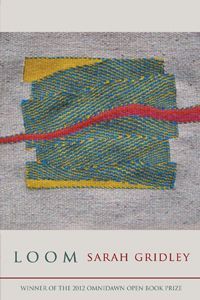Sarah Gridley’s new collection, Loom, is comprised of three stunning sequences whose organizing emblem is Tennyson’s “The Lady of Shalott,” a poem that so deeply haunted Gridley that she set out to memorize it in the summer of 2006 before leaving Maine for a teaching position in Cleveland. Throughout Loom Gridley places excerpts from Tennyson’s poem beside her own (sometimes autobiographical) lines:
Around about the prow
s[he] wrote
The Lady of Shalott.
It takes me a full summer to get
the whole of the poem by heart
Tennyson seems an unlikely influence for Gridley, who more likely fits into the lineage extending from HD to Barbara Guest. In her acknowledgments page Gridley thanks Martin Beisly, who put her “in touch” with Tennyson by way of a few nights’ stay at Farringford House, Isle of Wight. Gridley writes, “I could not have written this book without walking the Downs that summer.” Farringford House, Tennyson’s former home, is neighbor to Dimbola, former home of the photographer Julia Margaret Cameron, perhaps best known for making the 1865 portrait of Tennyson. Though officially titled, “Alfred Tennyson with book,” the Laureate came to call the portrait, “The Dirty Monk.” Indeed, Tennyson’s beard is a tangle of wiry hairs sprouting from his chin, a few white strands at the jowls. Were he to eat a bowl of soup, he would need to open his mouth impossibly wide to avoid soiling his mustache. In the portrait, Tennyson appears to have a complicated relationship to personal hygiene, and, perhaps by extension, mirrors.
The Lady’s mirror in Tennyson’s poem occupies a similarly ambivalent space by reflecting not only the vibrancy of life around the tower: “And sometimes thro’ the mirror blue/The knights come riding two and two,” but also the finality of death:
…in her web she still delights
To weave the mirror's magic sights,
For often thro' the silent nights
A funeral, with plumes and lights…
Of course, the mirror also helps to cast the fateful curse on the Lady:
From the bank and from the river
He flash'd into the crystal mirror,
"Tirra lirra," by the river
Sang Sir Lancelot...
…The mirror crack'd from side to side;
"The curse is come upon me," cried
The Lady of Shalott.
In Loom, Gridley harbors a similarly complicated relationship to mirrors. Where Tennyson’s mirror is first infused with color and shadow, the lavatory mirror in Gridley’s “Shadows of the World Appear” is actually preceded by the image it reflects:
Show her bottom’s blush in the scalding bath.
Show a stout cloud
of rose talc
where she dries to fragrant abstraction.
Following these lines, the reflecting agent (Gridley has yet to call it a mirror) becomes the same mirror that curses Narcissus; nature’s mirror made by still water: “Show us up to our waist in grass and water/rushes carding the clouds apart/on the glass-looking black of water.”
Perhaps one source of Gridley’s obsession over “The Lady of Shalott” is a result of her desire to pledge equal allegiance to Tennyson (as poet) and the Lady (as artist). In Loom, both become, as George Steiner suggests, “agencies in [Gridley’s] consciousness, pace-makers in the growth and vital complication of [Gridley’s] identity.” In the remarkable final sequence, “Half-sick of Shadows” the female pronoun nearly conflates Tennyson’s Lady with Gridley’s occasionally autobiographical speaker:
She grew up with a form of technology
called a record player. Each voice came about
by circumference.
Where the needle set devotion
on a scratch, the Lady listened
to the skipping sound:
From the bank
and from the river
He flash’d into the crystal mirror Tirra
lirra
by the river
Sang Sir Lancelot.
By repeating Tennyson’s/Lancelot’s “Tirra lirra,” Gridley seems to summon the curse that leads to the Lady’s ultimate demise. Equipped with language in a way that the Lady was not, Gridley trusts that her outcome will be vastly different. She also has history behind her. If Tennyson’s project was to suggest that the production of art occurs in melancholy isolation from the very world it mimics, Gridley’s poems engage the world in ways that invalidate the antiquated notion of the solitary, contemplative female figure by joining together an array of sources and subjects until they sparkle. The result is a text drawing from a variety of sources such as William James, Gautier, and the Gospel of Luke. Throughout Loom, Gridley sends into orbit other constellating emblems such as weaving and ecopoetics:
The warp is vertical, qualitative, a top-down scripture.
Goldenrod and rocket (though rocket
roots in distaff: a stick that holds
the flax for spinning).
Weft.
Weft is horizon—auxiliary, ornamental, washing the gloss
with further reflection—crane redoubling
the call of her mate—rouging silver and wildly cold
the winter ponds of crossing flights.
In the end, Loom is more than just a necessary updating of “The Lady of Shalott”; it improves on the narrow perspective of the isolated female artist by transforming Gridley’s ideas and interests into a lyricism that deeply enhances our understanding of the complexities of both the Victorian era, and our own contemporary moment.
